The stock market swoon in December of 2018 brought back the terrible memories of 2008 and 2009 for many investors. Extreme volatility is back and it was not a lot of fun watching the market swing from big gains to big losses in one day.
What History Has Shown
For those in retirement or very close to it, a 15% decline in the stock market over just a few short months can be gut-wrenching. This is of course why so many of us in the personal finance industry beat the drum of diversification so often. But what about people who have 20 to 30 years until they will need the funds from their retirement accounts? Should they really worry too much about month to month and even year to year gyrations in the stock market?
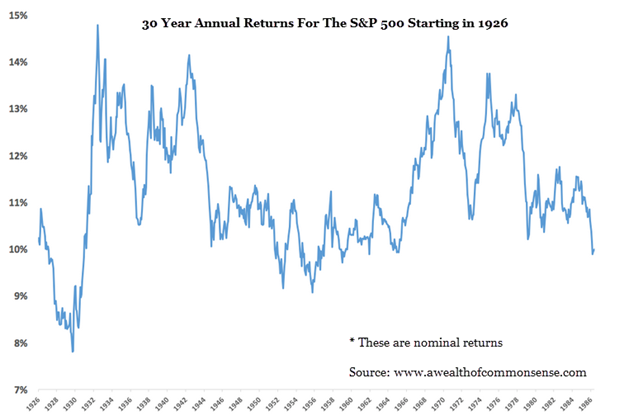
The graph above shows the rolling 30 year average annual return for the S&P 500 from 1926 through 1986. It is important to note that these returns do not have inflation stripped out, so they are not real returns. This means that in high inflation years such as the 70s and early 80s, the returns are not as good as they look.
The first thing in this chart that jumps out to me is the fact that there is not one 30 year rolling period where the average annual return is below 7.5%. For those investing for the long run, this is good news.
Another way to look at this data is to break it down by actual 30 year time periods rather than using rolling averages:
1926-1956: +10.8%
1956-1986: +9.6%
1986-2016: +10.0%
In the time spans shown above we have obviously had a lot of world-altering events including from 1926-1956 the Great Depression, World War II, and the Korean War. From 1956-1986 we had the Vietnam War, double-digit inflation, double-digit interest rates, the oil price shock, and six separate recessions. From 1986-2016 we’ve seen Black Monday (1987), the Savings & Loan Crisis, the first Iraq invasion, the invasion of both Iraq and Afghanistan, the financial panic of 2008/2009, and three separate recessions.
If you would like to quickly see the returns of the S&P 500 over any time period, I suggest checking out this site. If you want to calcuate the inflation rate over any time period in order to see the real rate of return, you can find the inflation rate over any time period here.
Time Horizon Still Matters
There are a lot of great things about being young and one of them is that you can take more risk in your retirement portfolio. A typical 30 year old won’t need the money in his or her retirement account for 30 to 35 years, which means the odds of doing well in the stock market go up substantially. This is crucial information to have when thinking about retirement planning, retiring early, and how to invest today.
I have talked to many young people about retirement planning and it is always surprising to see many of them with retirement accounts that have a substantial portion in bonds and cash. First off, most people that haven’t retired yet should steer clear of cash in their retirement portfolios. That is wasted money that earns ways less than inflation. People under the age of 35 should have a healthy portion of their retirement accounts invested in stocks for the long run. Remember, they won’t need this money for a long time, and when it comes to investing in stocks, time is your friend.
Some Examples Of How Time Horizon Matters
I used our financial and retirement planning software, WealthTrace, to run a plan for a 30 year old couple. If you are planning on being a do-it-yourself financial planner, don’t settle for free calculators. Make sure you use an accurate retirement planning application.
This couple currently has $50,000 saved to IRAs. This couple is very conservative and has decided to put only 30% of their retirement money into the stock market. We assume a 7% annual rate of return for stocks and 3% for bonds. They are saving $20,000 a year and will retire at age 65, when they will spend $60,000 per year.
I ran their retirement plan through Monte Carlo, which runs 1,000 different simulations using historical returns, volalitility, and correlations of the assets they are invested in. Monte Carlo gives us the probability that they will never run out of money. In this case, the probability of this couple never running out of money is 71%.
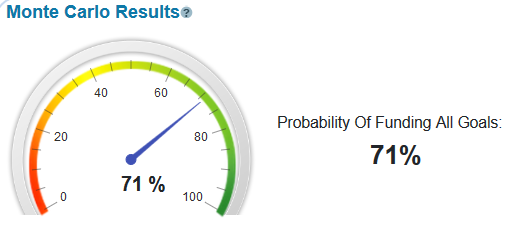
Their chance of running out of money is 29%, which is definitely too close for comfort. A big part of the problem is that they are not taking advantage of their long time horizon. They won’t need their retirement account money for 35 years, so they should be taking more risk. In other words, their allocation to stocks is way too low.
I adjusted their portfolio to be 90% stocks and 10% long-term bonds until they retire. When they retire, the will reallocate to a 50/50 mix. The results were much better:
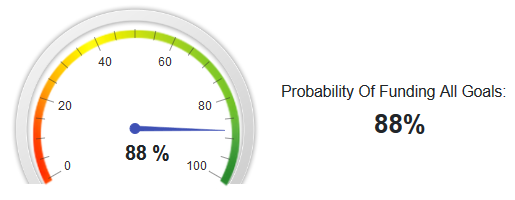
It should not be too surprising that their chances of retirement success went up by so much. Over a long enough time period, stocks have always outperformed bonds and Monte Carlo analysis takes this into account.
Now let’s look at the flip side of this example. We now have a couple that is 65 years old, just retired, and is 90% in stocks and 10% in long-term bonds. They are spending $60,000 a year in retirement and they have $600,000 saved, all in their IRAs. Their Monte Carlo results are:
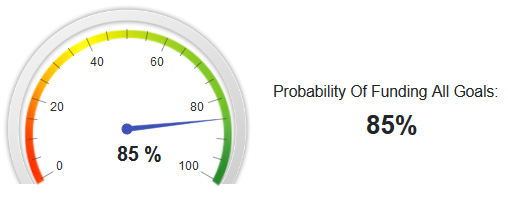
Having 90% of all your money in stocks at age 65 is not a great idea. One large market downturn can have a severe impact on one’s life at this age. Because they are spending their retirement money currently, that is money that will never have a chance to grow again once the market turns back up.
What if we move them to a more conservative 50/50 mix between stocks and bonds?
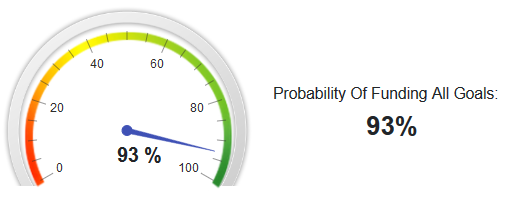
Moving them to a more conservative, diversified portfolio improves their chances of never running out of money. This makes intuitive sense because their time horizon is much shorter in terms of when they will need their retirement money. This also shows the benefits of diversification, especially as we get older and closer to needing our retirement money.
Find out if you are invested properly for retirement. Sign up for a free trial of WealthTrace today. Learn more about how WealthTrace can help you.